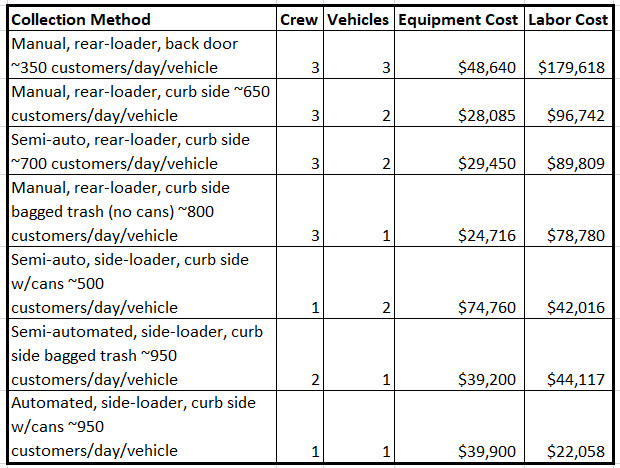Cost and Productivity Estimates
Figure 1 provides cost and productivity estimates for seven different refuse collection technologies, each serving 4,000 customers per week. The fully automated side-loading system serving 950 customers per day per vehicle is the most cost effective at an estimated $61,958 per year or $1.29 per customer per month. This figure does not include a number of costs common to the various methods, nor does it reflect what a customer’s monthly rate should be. It is merely a convenient method for comparing the relative efficiency of these refuse collection technologies.
Data in Figure 1 are based on the following assumptions:
- Labor cost is $505 per week for salary and benefits per crew member.
- Equipment cost is based on a six-year life cycle, and all costs are prorated to actual equipment use.
- Other costs not addressed, but common to all operations, include supervision, equipment insurance and storage, vehicle operation and maintenance based on vehicle usage, vehicle financing, other debt service, and overhead.
- Productivity rates (or customers served per day) are average figures that most cities should be able to achieve, the key words in that sentence being “average” and “most.” Circumstances vary among cities, and one size does not fit all. These rates assume that each crew works 40 hours per week, spends 30 hours on the route, and collects only refuse placed in containers or plastic bags. Data from a variety of jurisdictions around the country show that with proper management, equipment, and incentives, these or higher productivity rates can be met.
Figure 1

Note: This table does not account for equipment redundancy. Backup equipment is essential in refuse collection.
The most critical difference among the systems presented in Figure 1 are labor costs, not equipment costs. It is largely this labor difference — more than $150,000 per year between the most efficient and least efficient collection methods — that produces the overall system cost differences. The least efficient, of course, reflects rear door collection, which involves a policy decision. The same crews with the same equipment can provide curbside service at about one-half the cost per customer compared to back door collection. Figure 1 does not reflect what a customer’s monthly rate should be, nor does it consider other common overhead factors. Figure 1 also does not reflect equipment redundancy. Equipment redundancy does not always necessitate a purchase. Interlocal agreements and vendor contracts are alternatives to purchasing back-up equipment.
Some cities in Tennessee collect refuse twice per week. Using standard containers and automated or semi-automated systems, cities can save up to 40 percent on fuel costs by converting to collection once per week. The standard containers are adequate to handle a week's refuse for the average family and are virtually waterproof and spill proof. In addition, over the life of the containers they actually cost less to the homeowner than two garbage cans and a plastic bag per week. Automated and semi-automated technologies represent reliable, cost-effective methods of refuse collection, and they should be given serious consideration by almost every city that provides refuse collection service.
Data from cities as diverse as McMinnville, Tennessee, (pop. ~13,000) and Memphis, Tennessee, (pop. ~650,000) show that automated and semi-automated refuse collection can work well.
Public reaction to converting to curbside automated or semi-automated refuse collection can be critical to system success. Officials must anticipate the genuine concerns of citizens, answer those concerns honestly, and show citizens that the new systems will save taxpayer dollars while maintaining or improving refuse collection service. Also, cities should implement special programs for people such as the elderly and the handicapped whose physical limitations prevent them from wheeling refuse containers to curbside for collection.
In order to achieve significant savings, local communities must ensure that their new automated or semi-automated systems work effectively. Factors such as how to finance the system, how to deal with personnel displaced by automation, efficient route design, and proper maintenance of automated equipment must be taken into consideration well in advance of system implementation. These same criteria are relevant to cities that elect not to automate. Proper planning, training, staffing, maintenance, and methodology are key to the success of all residential refuse collection technologies.
| Equipment Quotation | |
|---|---|
| Projected budget figures to match the units in Figure 1: | |
| Manual rear loader, back door (HEIL 4000-16 2015 Ford F750) | $128,000 |
| Manual rear loader, curbside (HEIL 4000-20 2015 Ford F750) | $137,000 |
| Semi-automated rear-loader, curbside (HEIL PT1000-20 2015 Freightliner) | $155,000 |
| Manual rear-loader, curbside (HEIL PT1000-20 on 2015 Freightliner M2-106) | $148,000 |
| Semi-automated side-loader, curbside (Bridgeport Trinity-29 on 2015 Mack) | $280,000 |
| Manual side-loader, curbside (HEIL Multi-Task-28 on 2015 Mack LEU) | $280,000 |
| Automated side-loader, curbside (HEIL Python-28 on 2015 Mack LEU) | $285,000 |
| (Cart prices $65 to $70 range.) | |
